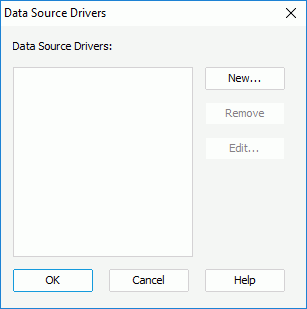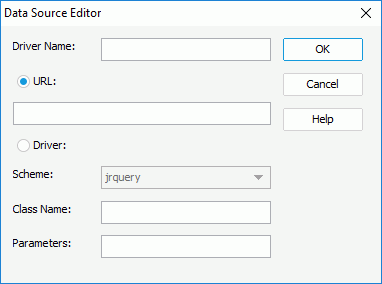Working with Cached Query Results
By default, when you run a report, Logi Report Engine fetches data from the database for the report, thus if you are offline and do not have a DBMS connection, you would not be able to load the report data. To help you avoid the inconvenience, Logi Report provides the Cached Query Result feature, which enables you to create cached result files for queries (and also imported SQLs, stored procedures, user-defined data sources, and business views that function similarly as queries), save them somewhere in your machine, and apply them to your reports that use the queries. Then, when you view the reports, Logi Report Engine fetches data from the files as opposed to the database. This is very useful for working on the design of a report while you are offline. It is also helpful when you have problems with your reports and need to send the reports with data resources to Logi Analytics for reproducing the problems. This topic describes how you can create cached query results, apply them to reports, and generate data source drivers for cached query results.
This topic contains the following sections:
- Creating Cached Query Results
- Applying Cached Query Results
- Generating Data Source Drivers for Cached Query Results
Creating Cached Query Results
You can create cached query results either in the Catalog Manager or in the Data panel.
- Creating a cached query result file in the Catalog Manager
- In the Catalog Manager, select the query for which you intend to create the cached query result file.
- Right-click the query, and select Create Cached Query Result from the shortcut menu.
- In the Save Cached Query Result dialog box, specify the file name with or without an extension and the folder where you want to save the result file. It is recommended to use an extension such as ".cqr" to help you identify the files. Designer does not provide a default extension.
- Select Save to save the cached query result file to the specified folder.
- Creating a cached query result file in the Data panel
- In the Data panel, right-click the query and select Create Cached Query Result from the shortcut menu.
- In the Save Cached Query Result dialog box, specify the file name with or without an extension and the folder where you want to save the result file and then select Save.
Applying Cached Query Results
To run a library component or a query-based page report using cached query result, you can set the Data Driver property on the dataset appropriately in the Report Inspector. You can specify the property value by inputting manually or selecting a predefined data source driver from the drop-down list.
The input format is as follows: jrquery:/jet.universe.resultfile.UResultFileResultSet;Fullpath_of_cached_query_result
For example, if you save the cached query result to C:\(Undefined variable: Logi_Variables.LogiReport)\Designer\Cached with the file name "test", the property value should be jrquery:/jet.universe.resultfile.UResultFileResultSet;C:\(Undefined variable: Logi_Variables.LogiReport)\Designer\Cached\test.
However, the Data Driver property is not available to web reports and business view-based page reports . In order to apply cached query result to them, you can select the option Use cached query result in the Catalog category of the Options dialog box. Then whenever you preview a report in Designer, Designer displays a dialog box for you to choose a cached query result to run the report.
Generating Data Source Drivers for Cached Query Results
When specifying the Data Driver property for a dataset, you may find it inconvenient to type in a property value that is long and complicated. To help you with this, Designer provides a tool for generating data source drivers for cached query results, which are then available in the Data Driver drop-down list for selection.
Assuming that you have created a cached query result file "orderstat_cached" for the query OrderStat in the catalog file SampleReports.cat and saved it in C:\(Undefined variable: Logi_Variables.LogiReport)\Designer\Cached, to create a data source driver for the cached query result, follow the steps below:
- Make sure SampleReports.cat is the currently open catalog file. If not, select File > Open Catalog to open it from
<install_root>\Demo\Reports\SampleReports. - In the Catalog Manager, select Data Source Drivers on the toolbar. Designer displays the Data Source Drivers dialog box.

Designer lists all the added drivers in the Data Source Drivers box. If you want to remove a driver, select the driver and select the Remove button. To edit a driver, select the driver and select the Edit button.
- Select the New button. Designer displays the Data Source Editor dialog box.

- Type a name for the driver in the Driver Name text box. Here, we name it OrderStat.
- Select the URL radio button and type the URL as follows:
jrquery:/jet.universe.resultfile.UResultFileResultSet;Fullpath_of_cached_query_result
In the example, the URL is
jrquery:/jet.universe.resultfile.UResultFileResultSet;C:\(Undefined variable: Logi_Variables.LogiReport)\Designer\Cached\orderstat_cached If you select the Driver radio button to specify the driver, you need to specify the class name and parameter of the driver as follows:
If you select the Driver radio button to specify the driver, you need to specify the class name and parameter of the driver as follows:
- Class Name: jet.universe.resultfile.UResultFileResultSet
- Parameter: Full path of the cached query result (
C:\(Undefined variable: Logi_Variables.LogiReport)\Designer\Cached\orderstat_cachedin this example)
Then, Designer generates a URL according to the information you specify.
- Select OK to add the driver.
- Select OK in the Data Source Drivers dialog box to close it.
- Now you can choose the driver from the Data Driver property's drop-down list directly without inputting the long value manually.
 Previous Topic
Previous Topic